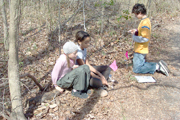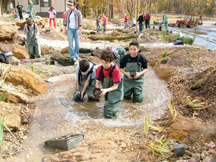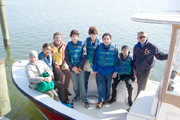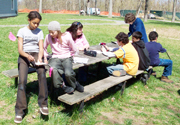|
||||||||
Learning From Where They LiveAt Chesapeake Bay Earth School, Chesapeake Bay — and Bay Weekly — Are Textbooksby Ben Miller
On a beautiful, mid-week spring day, six middle-school children boated on the West and Rhode Rivers, walked in the woods and gazed at clouds. No, the students didn’t cut class, Tom Sawyer style. For Win Reilly, Sharif Mabie-Alkhaldi, Thea Grusky-Foley, Ravi Kumar, Sky Lawson and Isaiah Baden-Payne, the Chesapeake Bay Home Schooling Collaborative was in session. Riverkeeping on the West and Rhode RiversThe school day started with the six 11- to 14-year-olds patrolling the West and Rhode rivers with Riverkeeper Bob Gallagher. Gallagher’s job is to seek sources of pollution and violations of environmental laws. They found plenty: an eel trap, brush cleared from the buffer zone to right above the water line, a pier built too far out into the river, an oysterman harvesting a restored oyster bed, a boat sinking beside a dock and a floating plastic chair, which they picked up. Along the way, they saw a bald eagle, ospreys, cormorants, buffleheads, surf scoters, swans, a loon, a pole net, watermen’s boats and an undisturbed shoreline preserved by private landowners and the Smithsonian Environmental Research Center. After all that, they got the fun of the boat’s fast return to the dock. All in a Day’s LearningFrom this adventure, students and teacher Rome
y Pittman returned to their classroom at the Ralph Bunche Community Center on Mill Swamp Road in Southern Anne Arundel County. In the temporary classroom rented from the community center, they reflect on what they’ve learned in the field, reach conclusions and plan new learning adventures. Most mornings, they study math, Latin and literature for one hour. The language they learn is ancient, but they’re not learning the ways their grandparents did. Instead of vocabulary and case drills, they’re reading the story of a Roman tomboy. Sky Lawson and Thea Gruskey-Foley explained how they must master the vocabulary for each lesson before they can follow the story. It’s “like cracking a code,” Thea says. Tomorrow, the small class draws on their skills in logic and rhetoric to debate whether George Washington was a hypocrite for owning slaves. Ravi Kumar and Isaiah Baden-Payne plan to argue that the commander of the Continental Army during the American Revolution and our first president, was indeed a hypocrite. Their evidence? Washington opposed slavery yet freed his own slaves only after his death, and not even then, by the terms of his will, but at the death of his wife, Martha. Win Reilly and Sharif Mabie-Alkhaldi will argue the other side: that Washington was a man of his times who did the best he could when slavery was widely accepted. Thea and Sky will judge. But the Earth is their primary classroom, and they’re in school regardless of weather. Every Wednesday since last September, they’ve tested the Rhode River for oxygen content, temperature, acidity, turbidity and salinity. Now they’re beginning to understand how the ecosystem works. Over winter, the water was less salty. Less evaporation in cold weather, Win and Sharif explained, was the reason for a smaller percentage of salt. They’re getting to know bogs as well as rivers. Isaiah Baden-Payne and Ravi Kumar say they’ve planted native species while helping restore a bog at the Smithsonian Environmental Research Center in Edgewater. Smithsonian scientists helped the kids; now the kids are designing a brochure to explain their work. Back in the Living ClassroomThis afternoon took the small class out to the field again. At the Smithsonian Environmental Research Center — where they’re schooled in a year-long science curriculum created by Jane Holly of the Center — they recorded soil temperatures for Izolda Trakhtenberg of the National Aeronautic and Space Agency. Satellites can determine soil temperature and moisture to the depth of five centimeters, Trakhtenberg said, but scientists need to validate the data with field-testing. Trees and other obstacles interfere with the satellite detection. The students measured soil temperatures in the forest, in sunlight and in shade at the depths of five and 10 centimeters. As expected, they found variation of temperatures, with the shaded soil being colder, and the deeper soil in sunlight being colder than the soil nearer the surface. A student who called his class budding scientists was corrected by Trakhtenberg. “You are scientists,” she said. “You are doing the science, my friend.” These sixth to eighth graders do experiments, collect data, replant bogs, learn edible plants as they explore the natural world of Chesapeake Country. A Pedagogy of Place
Romey Pittman and Claire Cambardella teach and guide the six scientist-students of the Chesapeake Bay Home Schooling Collaborative, which is sponsored by the Chesapeake Bay Earth School Inc. These six are officially enrolled in The Learning Community, a Maryland homeschooling umbrella organization. Confusing though its identity may be, its mission is clear. That, explained Pittman, is to “use the natural resources, economy and history of the local community as a starting point for understanding the world at large.” The best education, Pittman says, “grows out of the local community.” Thus the students of the Chesapeake Bay Home Schooling Collaborative explore big issues and subjects, learning through instruction and self-exploration and applying what they learn to understand the history, environment and community of the place where they live: Chesapeake Country. Pittman’s experiences as a student, educator and mother led her to believe that self-motivation and self-discovery are the keys to children’s learning and discipline. Pittman followed her teaching philosophy from Suitland High School, a public high school in Prince Georges County, to Fairhaven School, a private, self-styled democratic school in Davidsonville, then to this new alternative school. As students study the community, the culture and the environment, they are motivated by their excitement about what they are seeing and doing. Both teachers, Cambardella and Pittman, and students “read Bay Weekly religiously,” Pittman said, “since our program is based on a ‘pedagogy of place’ philosophy and there is no better source for local musings, reporting, and research, especially about the Bay itself.” Learning by Seeing and DoingThese students have seen and done much that could teach us all about the place where we live. To learn about race relations in Anne Arundel County, they talked to African Americans who lived near their school. To envision the lives of the Piscataway Indians, they interviewed Natalie Proctor, the Werowance of the Cedarville Band of the Piscataway Indians. They saw evidence of these people’s lives people at the Piscataway Indian Museum in Waldorf and used what they learned by helping build a replica of a Piscataway Indian Camp at the Smithsonian Environmental Research Center. To understand the economics of farming, they are growing sugar snap peas and plan to market them later in the spring. Are these sixth, seventh and eighth grad No, says Naomi Baden, president of the board of the Chesapeake Bay Earth School. These students’ knowledge of “content comes through their experience,” she said. Baden says students “learn by doing.” By learning specific information about the Bay and the rivers, they develop an understanding of “the broader world.” The students learn how to conduct research, solve problems and think critically. This type of learning, says Baden, is not “driven by accountability systems.” A newly wed retired National Park Service exhibit curator, Ben Miller is entering a second career as a writer.
|
||||||||
|
|
||||||||
|
© COPYRIGHT 2004 by New Bay Enterprises, Inc. All rights reserved.
|






 ers spending too much time on activities when they could be studying for standardized tests?
ers spending too much time on activities when they could be studying for standardized tests?